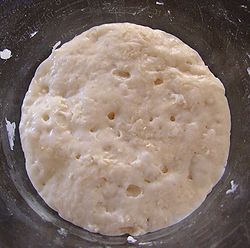
Biga (bread baking)
Encyclopedia

Italy
Italy , officially the Italian Republic languages]] under the European Charter for Regional or Minority Languages. In each of these, Italy's official name is as follows:;;;;;;;;), is a unitary parliamentary republic in South-Central Europe. To the north it borders France, Switzerland, Austria and...
baking
Baking
Baking is the technique of prolonged cooking of food by dry heat acting by convection, and not by radiation, normally in an oven, but also in hot ashes, or on hot stones. It is primarily used for the preparation of bread, cakes, pastries and pies, tarts, quiches, cookies and crackers. Such items...
. Many popular Italian bread
Bread
Bread is a staple food prepared by cooking a dough of flour and water and often additional ingredients. Doughs are usually baked, but in some cuisines breads are steamed , fried , or baked on an unoiled frying pan . It may be leavened or unleavened...
s, including ciabatta
Ciabatta
Ciabatta is an Italian white bread made with wheat flour and yeast. The loaf is somewhat elongated, broad and flattish. There are many variations of ciabatta.Ciabatta in its modern form was developed in 1982...
, are made using a biga. Using a biga adds complexity to the bread's flavour and is often used in breads which need a light, open texture with holes. Apart from adding to flavour and texture, a biga also helps to preserve bread by making it less perishable.
Biga techniques were developed after the advent of baker's yeast
Baker's yeast
Baker's yeast is the common name for the strains of yeast commonly used as a leavening agent in baking bread and bakery products, where it converts the fermentable sugars present in the dough into carbon dioxide and ethanol...
as bakers in Italy moved away from the use of sourdough
Sourdough
Sourdough is a dough containing a Lactobacillus culture, usually in symbiotic combination with yeasts. It is one of two principal means of biological leavening in bread baking, along with the use of cultivated forms of yeast . It is of particular importance in baking rye-based breads, where yeast...
and needed to recover some of the flavour which was given up in this move.
Composition and use
Bigas are usually dry and thick compared to the FrenchFrench cuisine
French cuisine is a style of food preparation originating from France that has developed from centuries of social change. In the Middle Ages, Guillaume Tirel , a court chef, authored Le Viandier, one of the earliest recipe collections of Medieval France...
poolish or a sourdough starter. This thickness is believed to give a Biga its characteristic slightly nutty taste. Biga is usually made fresh every day, using a small amount of bakers yeast in a thick dough, which varies from 37% to 50% water by total weight or 60% to 100% as a bakers percentage, and is allowed to ferment from 12 to 16 hours to develop its flavour fully.
After fermenting overnight, biga is then added to the bread dough in place of, or in addition to, regular baker's yeast, depending on the recipe, and the bread dough is mixed, kneaded, raised, shaped, proofed, and baked like any other yeast dough.
There are a few bread books whose authors specify a much higher hydration to the biga. Franco Galli, in his "Il Fornaio Baking Book," specifies a biga that is about 100% hydration, which takes it into the level of a French poolish. In general, however, a biga is a preferment of around 60% and the poolish is a pre-ferment of around 100%.

